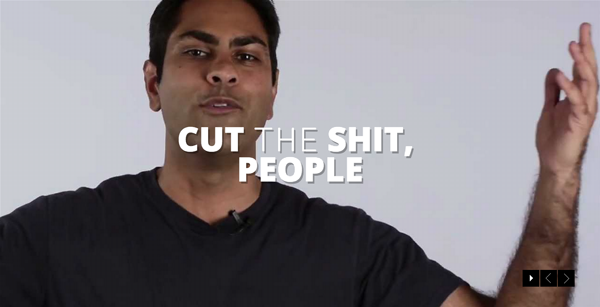If you want to learn how to give advice that people actually listen to, there are two things you can do:
- Empathize with the person — and not act like an emotionless robot.
- Find people who want to listen to that advice.
That’s it. Not following these steps will have you feeling like you’re giving advice to a brick wall.
I know because I spent years doling out unsolicited advice and wondering why people weren’t listening to me.
For example:
FRIEND: (sighing) I hate banks.
YOUNG RAMIT: (ALARM BELLS RINGING DUE TO A PROBLEM I CAN SOLVE) Why? What’s up?
FRIEND: They just charged me $34 for an overdraft fee. That’s like the third time this month.
YOUNG RAMIT: (deep inhale) LOL THAT’S SO DUMB, I NEVER GET OVERDRAFT FEES. YOU NEED TO AUTOMATE YOUR FINANCES AND LEARN HOW TO NEGOTIATE. IT’S SO EASY. FIRST YOU START BY CREATING A CONSCIOUS SPEND—
FRIEND:

I really wanted to help … and I knew the “right” answer.
But my friend wasn’t ready to hear it, so it landed with a thud.
It took me a few years to discover that people don’t like to be lectured about things they already know they’re doing wrong.
Can you think of any examples? Like, say, being in a bad relationship (“He treats you so badly! Why do you stay with him?”), losing weight, or money.
For a guy who prided himself on being “unemotional,” I quickly realized that I was missing something important: BEING ABLE TO PUT MYSELF IN THEIR SHOES WHEN I GAVE ADVICE.
Good advice has probably helped you before, just like it’s helped me. So what if we could turn around and learn how to give it in a way that actually resonated with people?
That’s why I’d like to republish this 2015 observation from my friend Darya Rose, successful author of Foodist: Using Real Food and Real Science to Lose Weight without Dieting and star IWT student, for a great system to help you give advice people will actually listen to.

Source: Summer Tomato
Oh, and she has a Ph.D. in neuroscience and is the creator of Summer Tomato, one of the best personal development sites out there … so I suggest you listen to her.
Take it away, Darya.
How-to-give-advice system #1: Communicate emphatically
The Golden Rule has been letting me down my entire life.
While “treat others as you would like to be treated” makes sense on the surface, it really only works if you assume that people more or less prefer to be treated in the same way.
Unfortunately, this isn’t always true. And it can cause some serious communication barriers.
I am a member of a rare group of people who are driven more by logic than emotion. Think Mr. Spock.

Source: StarTrek.com
As a female member of this low-emotion group, I’m even more rare. Like a pink unicorn.
You probably know a few people like me. We are often described as “cold” and “aloof,” but are also considered “low drama” and great problem solvers. We are rarely known for our suave people skills.
It turns out what distinguishes low-emotional people from regular people (if you’re a follower of Jungian psychology you might call these people “Thinkers” and “Feelers,” respectively) is how much we rely on empathy to communicate.
Empathy is the ability to understand and share the feelings of another person. Normal people rely heavily on empathy for most interactions.
If you’re wondering why this needs explaining, you’re probably normal.
But if you’re a Thinker like me, this could be news to you.
Thinkers, unlike Feelers, have a very low need for empathy. We don’t need to feel “heard” or “understood” in order to connect with someone. For this reason, we have difficulty understanding the need for empathy in others.
More often than not, the emotional component of a tactical problem such as losing weight, seems obvious and somewhat trivial to a Thinker. Of course you want to get healthy and look great. We all do. Duh. Instead, we prefer to skip straight to possible solutions.
Unfortunately, unless the person receiving the advice also happens to be a Thinker, even the best information will likely go unheeded.
It isn’t that Thinkers do not have emotions or the capacity for empathy. In fact, in an obviously emotional situation such as a bad break-up or losing a loved one, we can be very empathetic and great friends to have.
It is in situations where emotions aren’t front and center, especially those that involve advice or problem-solving, where a Thinker’s lack of understanding of a Feeler’s emotional needs will prevent effective communication.
The good news is that empathetic communication can be learned. With practice, even low-emotional people can be empathetic in situations that involve advice or problem-solving.
If you’re a Thinker, developing the skill of empathy will allow your advice to reach more people and have far greater impact.
Here are the essential steps for empathetic communication:
Step 1: Listen deeply for the emotional undertone of what someone is saying
As a Thinker, your natural tendency is to listen solely for facts. This is great for problem-solving, but remember that to get a person to listen to your advice you also need to address their emotions.
For example, when someone says: “I would really love to lose 15 lbs.”
You hear: “I need tactics to lose a moderate amount of body fat.”
They really mean: “I need to feel supported by XYZ.”
But behind the words is a deeper emotion that can’t be addressed by tactics, and your job is to figure out what that is. Instead of skipping straight to the advice, try to uncover her hopes, fears, and dreams.
Instead of: “That’s easy, just do X.” Ask: “Oh really? What have you tried?”
Listen for signs of fear, frustration, hope, and other underlying emotions. Pay attention to the words they are using, as well as tone and body language if you’re speaking in person.
Sometimes people are straightforward in explaining their fears and say things like, “I’m afraid I’ll put in all this effort and still fail.” Fear of failure is extremely common, and being able to recognize it is essential.
However, you may need to ask additional questions to get to the core emotion. The use of generic statements that start with “I know I should…,” “I don’t have time…,” or “I don’t like (insert any broad category or action)…” imply that there is a fear or aversion lying below the surface of their words that they are avoiding.
Similarly, generalization statements and using words like “always” or “never” imply an underlying invisible script that reflects a hidden emotion. Continue asking “why?” until you get an answer.
For instance, if a woman tells me she would like to cook healthy meals but that it is always too much work, I’ll ask her why it’s so hard. Often I’ll hear something like, “My husband refuses to eat anything healthy, so I’m forced to make two separate meals if I want to eat well.”
Now we’re getting somewhere.
Step 2: Try to name the core emotion
From the above response, you might guess the woman feels unappreciated, frustrated, helpless, or insecure about her cooking skills. Once you think you have a good idea of what her emotional state is, test your hypothesis by asking directly:
“Wow, that must be incredibly frustrating. Why do you think he’s so stubborn?”
“I think it’s because his mother was a terrible cook, so he won’t even try anything I make except meat and boiled potatoes. I’m actually a pretty good cook, but he won’t give me a chance.”
She feels frustrated and unappreciated.
Step 3: Relate to the emotion to show understanding
Once you’ve discovered the core emotion, you must show that you can relate to the feeling. There are several ways you can do this:
Mirroring
Sometimes simply repeating back or “mirroring” the emotion is enough to demonstrate your understanding.
This can feel very basic and pointless if you’re a Thinker, but it is in fact incredibly effective. If you’re new to empathetic communication, this is the perfect place to start practicing. Once you see how effective this technique can be it gets easier to use it in everyday conversations:
“You’re a great cook and he won’t even try your food. That must feel terrible.”
“Yeah, it really sucks.”
Be vulnerable
Sharing an experience you’ve had that evoked a similar emotion is also an excellent way to show your understanding. This is called vulnerability.
Vulnerability is a more advanced form of empathetic communication, but it is by far the most effective technique if you can master it.
Everyone has stories and emotions that relate to those of others. The difficulty for a Thinker is remembering to share the emotion rather than the tactical solution. From the listener’s perspective though, the more you share, the more you care:
“Oh man, my dad is the same way. I made the most amazing brussels sprouts for Thanksgiving and he wouldn’t even touch them. I put bacon on them and everything. It was so upsetting, I’d hate to go through that every single night.”
“Yeah, it makes it really hard.”
Validate emotions
Another way to show your understanding is to validate the emotions by explaining with logic how you can see their point of view.
Thinkers can be quite good at this, since it plays to our natural tendency to be rational. The major difference here is that we’re focusing on the emotion rather than solving the problem:
“You put in all that work of shopping and preparing delicious food so you can have a tasty and healthy dinner, and he won’t even try it once. That doesn’t seem fair to you. And besides, heart disease runs in his family. He should at least give you the benefit of the doubt and try to eat a little better. After all, you’re only doing it because you love him.”
“Totally. I don’t understand why he can’t see that.”
Note that this technique works even if you disagree with the person’s analysis. However explaining that you understand how they came to their conclusion can create the necessary emotional connection. You can work on correcting their logic after that connection is established.
Step 4: Withhold judgment
If you’re a Thinker, chances are you knew what the person’s problem was within the first few moments of the conversation. However, it is essential that you withhold judgment of the other person’s actions, feelings or goals, or she will immediately shut you out.
In the example above, old Darya would have instantly exclaimed, “Stop using the word healthy! Nobody wants to eat ‘healthy’ food. Think that’ll get you anywhere with him? Hell no.”
And I would have received the predictable response:
“Hmmm … I don’t know. I don’t think he’ll ever eat the vegetables I make.”
Even worse would have been if I’d judged her feelings:
“Don’t feel bad about him, you know what’s best. Just feed him whatever you want and if he doesn’t like it he can cook for himself.”
“Hmmm … maybe.” Silently thinks: no way I’m jeopardizing my marriage for a stupid plate of broccoli. This chick has no idea what she’s talking about.
Telling people they are wrong has the opposite effect of empathy, and instead conveys to them that they are not understood. If you wish to be a helpful and effective communicator, you must resist the urge to rush to judgment.
Step 5: Offer advice last
Once you’ve listened carefully to the other person’s situation and demonstrated your understanding of their emotions without expressing judgment, you can carefully begin offering advice.
Low-emotion people tend to assume that the help they have to offer is the most important part of the conversation and like to offer it immediately. But someone will be far more likely to listen and accept your advice if you first establish a deeper connection.
By the way, if you’re a Feeler offering advice to a Thinker, feel free to skip steps 1-4 and jump right into the advice. We appreciate it.
How-to-give-advice system #2: Ask “How serious are you?”
Thanks, Darya!
That’s just one system you can use to give advice though. The next system involves discerning people who will actually listen to you from everyone else.
Check out this email I got a while back from a guy frustrated with his mom:
From: “J.”
Subject: My question is your next blog topic.
To: ramit@iwillteachyoutoberich.com
My mother is a hot mess. In a sense, I arose from the ashes of poverty while she still hangs her hat there. She came to visit for Thanksgiving and asked me how I “made my millions” (slight exaggeration) so she could too. I don’t know how to tell her she sucks with money and that she needs to get her shit straight before she can dream of island vacations, or even owning a new car on her own.
Thoughts on how to tell a single mom who raised a half a dozen children who’s 60+ years old that she doesn’t know what the hell she’s doing and needs to get her shit in gear?
You’re the man. If you have questions, I’m available on my cell or by email.
All the Best,
J.
Well, well, well. We’re basically meeting 20-something Ramit — morally righteous, judgmental, and just enough knowledge to be dangerous (but not enough to actually change people positively).
My response:
———- Forwarded message ———-
From: Ramit Sethi
Subject: Re: My question is your next blog topic.
To: “J.”
stop being so judgmental. your language reeks of it
start with one simple thing she can do. ONE, not 20.
help her instead of judging her
once she does one thing, move on to 2. that means asking if she is ready to move to the next one, not pushing it on her.
eventually, you can get her my book (or any other good money book) and work through it with her.
notice at least 50% of helping her is changing yourself, not just her.
-Ramit
Though I could have summed up my email in just one picture:

The worst people in the world are people who just learned enough to be dangerous (typically, people who just learned about paleo, weightlifting, personal finance, or religion). They’ve gone through the journey of deciding to change their life, so now they believe everyone needs to join them … without realizing that three months before, they wouldn’t have wanted to hear any of that!
So what do you do when someone asks you for advice?
First, resist the temptation to launch into how “simple” and “easy” it is. If it was easy, they would have already done it.
Second, you want to measure how serious they are. Are they just asking to complain? Do they just want you to tell them they’re doing fine (i.e., what a surprising number of people want: validation). Or do they actually want detailed, specific advice?
This is why you ask them one question:
NOW LISTEN CLOSELY.
If their response is anything other than, “I’m ready. I’ll do anything you say,” THEY DO NOT WANT YOUR ADVICE!!
Just smile and say, “You’re doing great. I’m sure you’ll figure it out.”
People who really want advice will say a very specific set of words. Anything else means you are walking into a minefield. It’s kind of like saying “Do you love me?” to your spouse. If they say anything other than, “Of course!” you’re in trouble.
For example, let’s say someone asks you how you lost 20lbs. You listen, nod, and say, “Well, I can tell you. Out of curiosity, how serious are you?”
PERSON 1: I want to! I’m just so busy, but I’m hoping I can fit in with my job and–
STOP. They don’t really want to know how you count your macros and your gym splits.
YOUR ANSWER: I just hit the gym and watch what I eat.
(This is why extremely fit people lie to their friends about their workout regimens.)
Another example:
PERSON 2: Yeah, I’d love to know! I follow this Instagram girl and I tried a 30-day challenge, but I can’t seem to find the motivation…
YOU: It sounds like you’re doing great! Keep it up!
It might seem unsatisfying to not answer their question, but they don’t really want your technical advice. They want to feel encouraged. That is totally fine.
Final example:
PERSON 3: I’m serious. I’ve tried 5×5, I did Stronglifts, but I really want to know how to make this part of my life. I’ve seen you stick with it for three years and I want to know how. I’ll do whatever you did.
YOU: Awesome! Tell you what — start off by tracking your food for a week and going to the gym 2x next week. Doesn’t matter what you do — just go. Send me an email next Sunday and we’ll talk.
Notice two things with the last example — these are important.
- It seems unfathomably rare that anyone would actually say, “I’m serious. I’ll do whatever you tell me to.” Almost nobody ever says this, because almost nobody really wants advice to the level of following through. They want to complain, they want to feel validated, but fewer than 1 in 1,000 actually want to change their behavior. It took me 10 years to truly internalize this. Once you do, you’ll start to be more understanding and empathetic, instead of frustrated.
- Even though they say they are 100% serious, I still didn’t dive into the deep, technical “how to” because they are not ready. You’re doing them a favor by parceling out your advice — and you’re giving them a minor barrier to see how serious they really are. Anyone can “say” they’re serious. Now let’s see if they email you on Sunday. This is an example of using barriers strategically.
You can give people the best advice in the world, hand them the best tactics, techniques, and strategies but it still won’t work until the pain of staying the same outweighs the pain of putting in the work and making a change.
How to give advice ANYONE will listen to
Whether you take Darya’s advice or you’re ready to ask someone, “How serious are you?” you should be ready to give out helpful advice to anyone who needs it.
That means having the intuition to recognize those moments and the confidence to jump right into those social situations.
If you need help getting there, I want to give you something to help.
First, here’s a video I made to help you improve your social skills in 40 minutes. It’ll help you better position yourself to give advice anyone will listen to.
Second, my team and I have worked on something to help you take your social skills to the next level:
This is my FREE guide to help you navigate any confusing social situation. You’ll learn how to:
- Make small talk. I reveal the common mistakes most people make and show you some simple ways to make small talk with anyone.
- Overcome shyness and build confidence. These are my best strategies on overcoming anxiety and being confident in group settings.
- Be more likable. Transform yourself into that person who can walk into any bar or party and talk to anyone with ease.
Enter your information below and get started building amazing social skills today.
How to give advice that people actually take is a post from: I Will Teach You To Be Rich.
Via Finance http://www.rssmix.com/
No comments:
Post a Comment